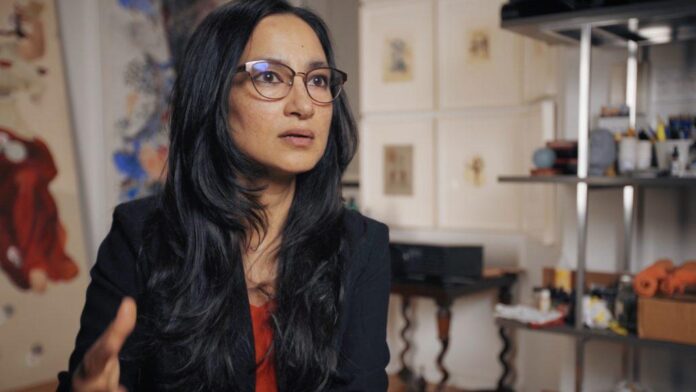Less than a block away from Madison Square Park—a beloved oasis of green space, dog-run enclosures, Shake Shack, and a stone’s throw from the tony stores that line Madison Avenue—stands the Courthouse of the Appellate Division, First Department of New York City, a functional building of law and order. On the courthouse roof, nine sculptures of historical men including Confucius, Justinian, King Louis IV, and Moses stand at attention, representing justice and virtue. Now, they are finally joined by a female figure.
Artist Shahzia Sikander’s first major outdoor project “Havah… to breathe, air, life,” comprised of two sculptures and an A.R. activation, is installed now at both Madison Square Park and the courthouse, featuring tall female figures representing power, justice, and equality.
Though the image of justice has traditionally been depicted in the form of a blindfolded woman holding scales to indicate the impartiality of the system, in Sikander’s rendering, the forms stand tall with their eyes wide open. The figures each don decorative collars or jabots, made famous by the late Supreme Court associate justice Ruth Bader Ginsburg, who wore lace and jeweled accessories with her black robes.
Sikander has spent much of her career focused on the traditional manuscripts of Iran and India, though much of those original works were not available for her as a student in Pakistan. In an exclusive interview as part of Art21’s series, Sikander reflects on how that early experience and the legacy of colonialism continue to affect art history.

Production still from the Extended Play film, “Shahzia Sikander: Melting Boundaries.” © Art21, Inc. 2023.
“Erasure. Lack of visibility. These things are at the core of my relationship with art,” she explained, adding that for the public art commission she was drawn to expanding the idea of “what monuments could stand for.”
The notion of erasure has been present within the United States judicial system, with very few women serving on the Supreme Court and the recent bouts of legislation eroding women’s reproductive rights. Besides nodding to Ginsburg’s sartorial flair, the sculpture at the courthouse wears a skirt inspired by its stained glass ceiling, symbolically representing the shattered glass ceiling of female empowerment and success.
“Whenever we create art and put something in the world, I believe it just pushes the envelope of who gets to be represented a little further” Sikander said in the video. “These things are really integral to how art can then negotiate a space for a future generation.”
Watch the video, which originally appeared as part of Art21’s series Extended Play, below. “Shahzia Sikander: Havah…to breathe, air, life” is on view through June 4, 2023.
This is an installment of “Art on Video,” a collaboration between Artnet News and Art21 that brings you clips of news-making artists. A new season of the nonprofit Art21’s flagship series Art in the Twenty-First Century is available now on PBS. Catch all episodes of other series, like New York Close Up and Extended Play, and learn about the organization’s educational programs at Art21.org.

























